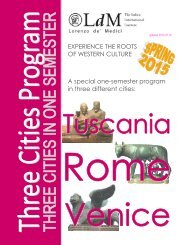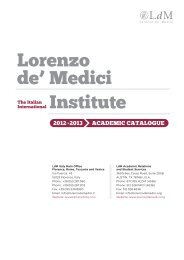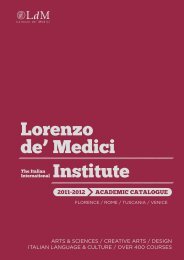aCademiC Catalog 2013-2014 - Lorenzo de Medici
aCademiC Catalog 2013-2014 - Lorenzo de Medici
aCademiC Catalog 2013-2014 - Lorenzo de Medici
You also want an ePaper? Increase the reach of your titles
YUMPU automatically turns print PDFs into web optimized ePapers that Google loves.
Renaissance Historical Dance<br />
PER 270 F<br />
Cr: 3; Contact hrs: 45<br />
The course introduces stu<strong>de</strong>nts to the different dance styles<br />
during the Renaissance, including a practical approach to body<br />
posture. The course presents the origins as well as the historical<br />
and social value of dance in the different social classes during<br />
the 15th century. It also offers a practical approach to using<br />
steps, gesture, and movements of 15th century dances to<br />
express feelings. A general historical overview will be covered<br />
by explaining the main differences among the various dance<br />
styles.<br />
Intermediate Ballet<br />
PER 300 F<br />
Cr: 3; Contact hrs: 45<br />
This course is for stu<strong>de</strong>nts who already have a basic knowledge<br />
of the studies listed in the elementary level course. In the<br />
intermediate level, barre and center exercises are more<br />
<strong>de</strong>tailed, complex and intensive. This course also inclu<strong>de</strong>s<br />
adagio exercises, turn outs, jumps and point study. Studies on<br />
the history of ballet with a special look at the Romantic period<br />
will be inclu<strong>de</strong>d.<br />
Prerequisites: PER 143 Introduction to Ballet, or equivalent<br />
Film, Vi<strong>de</strong>o and Multimedia<br />
Production<br />
Introduction to Digital Filmmaking<br />
FVM 210 F<br />
Cr: 3; Contact hrs: 90<br />
The course is based on the script, the language of images,<br />
and the figurative and narrative components of the story. I<strong>de</strong>a,<br />
story line, treatment and screenplay will be covered, as well<br />
as literary and original screenplays. The different roles of the<br />
production team will be analyzed: preparation: casting and<br />
work plan; technical means of directing (techniques of cinema<br />
/ vi<strong>de</strong>o shooting styles); lighting techniques and rudimental of<br />
photography; editing: construction and <strong>de</strong>finition of the film<br />
story line; editing methods with digital formats; audio postproduction<br />
(mixing and dubbing). The course aims to connect<br />
the different stages of production to provi<strong>de</strong> the stu<strong>de</strong>nt with<br />
a global view of the expressive power of the media from the<br />
creative to the realizable.<br />
Un<strong>de</strong>rstanding Movies: Theory and Practice<br />
FVM 215 F; Dual listed: MCT 215 F<br />
Cr: 3; Contact hrs: 45<br />
Moving images are among the most distinctive innovations and<br />
experiences of the last century and remain one of the most<br />
enduring. In a media-<strong>de</strong>pen<strong>de</strong>nt culture, <strong>de</strong>veloping a critical<br />
un<strong>de</strong>rstanding and practical knowledge of this form are vital.<br />
This course studies the theory as well as the techniques of<br />
filmmaking. It analyzes the ever-evolving cinematic language<br />
in terms of both its historical <strong>de</strong>velopment and its essential<br />
elements, techniques and tools. Through the study of stylistic<br />
choices and the construction of images and sequences,<br />
stu<strong>de</strong>nts learn aesthetic and technical terms, rules, conventions,<br />
and social assumptions used to build meaning. In a series of<br />
stylistic exercises, stu<strong>de</strong>nts engage in hands-on experience of<br />
vi<strong>de</strong>o shooting.<br />
Digital Filmmaking<br />
FVM 275 F<br />
Cr: 3; Contact hrs: 90<br />
The course <strong>de</strong>als with the three phases of the production of a<br />
professional vi<strong>de</strong>o. The aim of the course is to give stu<strong>de</strong>nts<br />
all the necessary means to produce and make a professional<br />
vi<strong>de</strong>o. Phase 1 - Pre-production: a) Structure and analysis of the<br />
screenplay; b) Working plan organization of the film and vi<strong>de</strong>o<br />
production. Phase 2 - Production: Set <strong>de</strong>coration, lighting,<br />
shooting, directing. Phase 3 - Post-production: Editing (with<br />
AVID XP software), sounding, mixing.<br />
Prerequisites: FVM 210 Introduction to Digital Filmmaking, or<br />
equivalent<br />
Vi<strong>de</strong>o Art<br />
FVM 293 F; Dual listed: ART 293 F<br />
Cr: 3; Contact hrs: 45<br />
This course is inten<strong>de</strong>d to be a theoretical and practical<br />
introduction to vi<strong>de</strong>o art as a discipline of contemporary art.<br />
The use of vi<strong>de</strong>o as a form of artistic expression has been<br />
continuously growing in importance. In the 90’s, the use of<br />
vi<strong>de</strong>o art actually surpassed that of the more traditional art<br />
techniques and traditional photography. Today, the systematic<br />
use of color, the shortening of projection times, the use of the<br />
big screen or different projection spaces and the introduction<br />
of special effects (thanks to the combination of the computer<br />
and digital techniques) all work together to make vi<strong>de</strong>o art<br />
a high-potential, imaginative, artistic language that offers an<br />
alternative to that of cinema. In this course stu<strong>de</strong>nts will acquire<br />
both familiarity with vi<strong>de</strong>o art as an art form and the technical<br />
skills to begin to create their own works in the medium.<br />
Prerequisites: ART 180 Art History I, or ART 186 Art History II,<br />
or equivalents<br />
Communications Internship: Web TV<br />
FVM 361 F; Dual listed: COM 361 F<br />
Cr: 3; Contact hrs: 135<br />
This course provi<strong>de</strong>s practical and professional experience in<br />
the field of Communications at a distinctive Italian placement<br />
site. The intern is monitored by both the onsite supervisor and<br />
an LdM faculty member. The gra<strong>de</strong> assigned by the faculty<br />
internship supervisor reflects assessment of weekly reports,<br />
two papers, and an overall evaluation. Ten hours weekly at the<br />
internship site; stu<strong>de</strong>nt internship schedules and onsite duties<br />
may vary. The placement is with the LdM Web TV offices;<br />
interns may <strong>de</strong>velop and carry out various types of ongoing<br />
and special activities which may inclu<strong>de</strong> but are not limited to:<br />
script writing, multimedia writing, interviews, research, vi<strong>de</strong>o<br />
work, editing, website management.<br />
Note: Placement opportunities are limited and subject<br />
to change. Stu<strong>de</strong>nts who enroll must submit supporting<br />
documentation by the registration <strong>de</strong>adline, and acceptance is<br />
conditional upon result of an onsite interview during the first<br />
week of the term. Fluency in Italian may be advantageous.<br />
Prerequisites: Communications/Journalism majors of junior<br />
standing<br />
Painting, Drawing and Mixed<br />
Media<br />
Principles of Drawing and Composition<br />
PDM 130 F<br />
Cr: 3; Contact hrs: 60<br />
This course will teach the basic techniques of figure and<br />
object drawing. The program is <strong>de</strong>signed to introduce the<br />
fundamental principles and elements of drawing as well as<br />
the major techniques and media. Each lesson has a specific<br />
aim and forms part of a progressive build up of skills. Still life,<br />
human figure, architecture and nature will be investigated as<br />
subject matter. Stu<strong>de</strong>nts will be introduced to the fundamental<br />
principles and elements of drawing using charcoal, pencil and<br />
various other media. Reference to the exceptional works of art<br />
in the city of Florence will be investigated and analyzed as an<br />
integral part of the course. The aim of the course is to <strong>de</strong>velop<br />
a better un<strong>de</strong>rstanding and knowledge of drawing, and to<br />
encourage further studies using the various techniques and<br />
media in creating drawings.<br />
Foundation Oil Painting<br />
PDM 140 F<br />
Cr: 3; Contact hrs: 90<br />
This course is an introduction to the traditional techniques<br />
of oil painting for beginning stu<strong>de</strong>nts or stu<strong>de</strong>nts with no<br />
previous training in Fine Arts. The course <strong>de</strong>als with the most<br />
fundamental principles and elements of still-life painting, with<br />
an emphasis on the perception and build up of form, tone, and<br />
color on a two-dimensional surface. Exercises are introduced<br />
to stu<strong>de</strong>nts in highly structured lessons, including the theory<br />
of color, supplemented by practical <strong>de</strong>monstrations. Reference<br />
to the exceptional works of art in the city of Florence will be<br />
School of Creative Arts FLORENCE<br />
LdM Aca<strong>de</strong>mic <strong>Catalog</strong> <strong>2013</strong>-<strong>2014</strong><br />
89





